A Piece of Billie Holiday’s Harlem is Disappearing
After a devastating fire, the NYC home of this jazz legend is being demolished!


New York City’s historic private clubs are a vestige of an older world, and the rise of newer, hipper clubs like Norwood and Neue House, reflects a desire to expand the vocabulary of what a private club consists of. At Untapped New York, we’ve been to a lot of these clubs for varying reasons – for events, for meetings, and as members. Here’s what we’ve discovered about 10 notable private clubs among the city’s oldest that have stunning architecture and rich history.
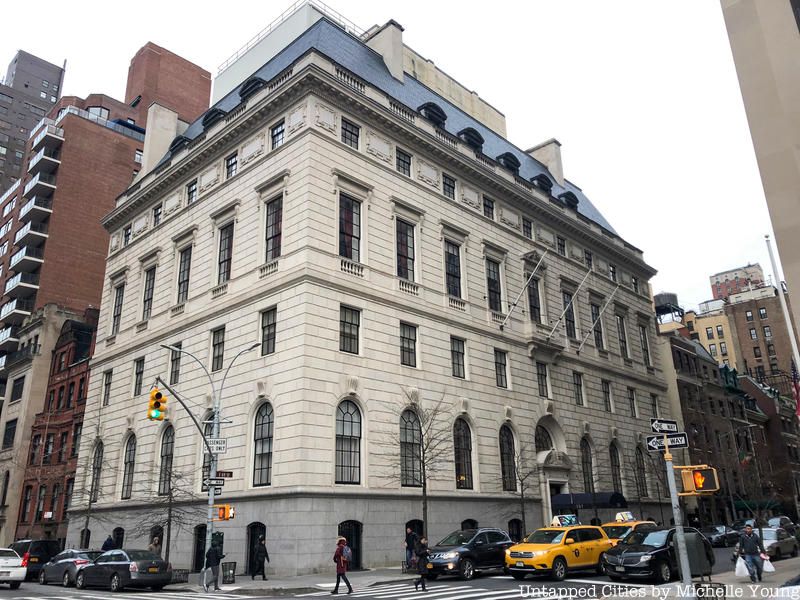
The Union Club is the oldest private club in New York City (but not the oldest in America). The grande dame of the private clubs, the Union Club is now located in a landmarked building designed by Delano & Aldrich on 69th Street and Park Avenue, after two moves from downtown. Not surprisingly, the Union Club is known for its conservative slant and its policies were the reasons for the founding of rival clubs, The Knickerbocker and the Metropolitan Club later. The club is still in operation and counts Dwight D. Eisenhower, Winston Churchill, Ulysses S. Grant, and William Randolph Hearst among its notable members.
The Union Club has a website (unlike the Knickerbocker) but it’s for members only. Guests (and potential guests) can read about club rules and dress code (like no use or display of cell phones in common areas) here.
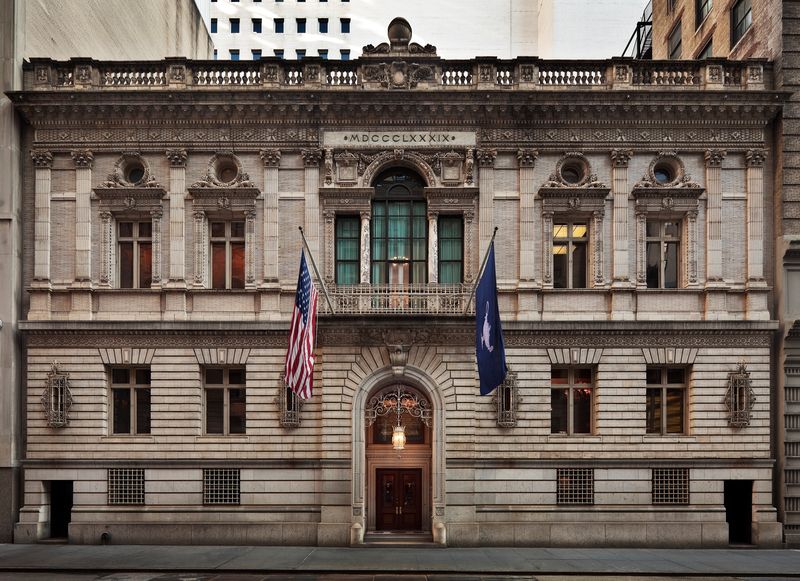
The Century Association was founded in 1847, evolving from the Sketch Club, a group of artists and writers, The Column, and the Bread and Cheese Club, founded by James Fenimoore Cooper. The club met in various different locations before settling into a clubhouse at 7 West 43rd Street in 1891. (Note: This is our second home, our first was at 109 East 15th Street from 1857 to 1891). The clubhouse, where the Association is still housed today, is a five-story Palazzo-style building designed by the illustrious firm of McKim, Mead, and White.
Today, the club’s membership is made up of two thousand authors, artists, and amateurs of letters and fine arts. To qualify as “amateurs,” individuals may be “of any occupation provided their breadth of interest and qualities of mind and imagination make them sympathetic, stimulating, and congenial companions in a society of authors and artists.” Famous members have included William Cullen Bryant, Louis Comfort Tiffany, Calvert Vaux, Carrère and Hastings, Frederick Law Olmsted, and McKim, Mead & White, among eight former Presidents of the United States (including Theodore and Franklin Delano Roosevelt), 10 Supreme Court Justices, Nobel Prize laureates, and members of the Rockefeller, Vanderbilt, Roosevelt, and Astor families. I’d drop the big families! That’s not the big Century preoccupation. The list is a little architect heavy — If you want to diversify we have also counted Winslow Homer, Rudyard Kipling, Kitty Carlise Hart, Kurt Vonnegut, Ralph Ellison, Jacqueline Kennedy Onassis, Benny Goodman, Dr. Suess, Brook Astor, Thornton Wilder, Edward R. Murrow, Henry James, and Aaron Copland as members.

The Harmonie Club, founded in 1852, is the second oldest private club in New York City. Originally called “Gesellschaft,” it was created by a group of six German New Yorkers after they were denied admittance to the Union Club. The membership base of the Harmonie Club is made of men and women who are prominent leaders in the worlds of business and finance, law, science, medicine, arts, and all walks of life.
The gorgeous Beaux Arts building that houses this club was designed by noted architect Stanford White in 1905. It was the second clubhouse. While a basement bowling alley and upper-floor bedrooms have been removed, the building still retains the original dining room designed by Stanford White, as well as other impressive Club facilities.
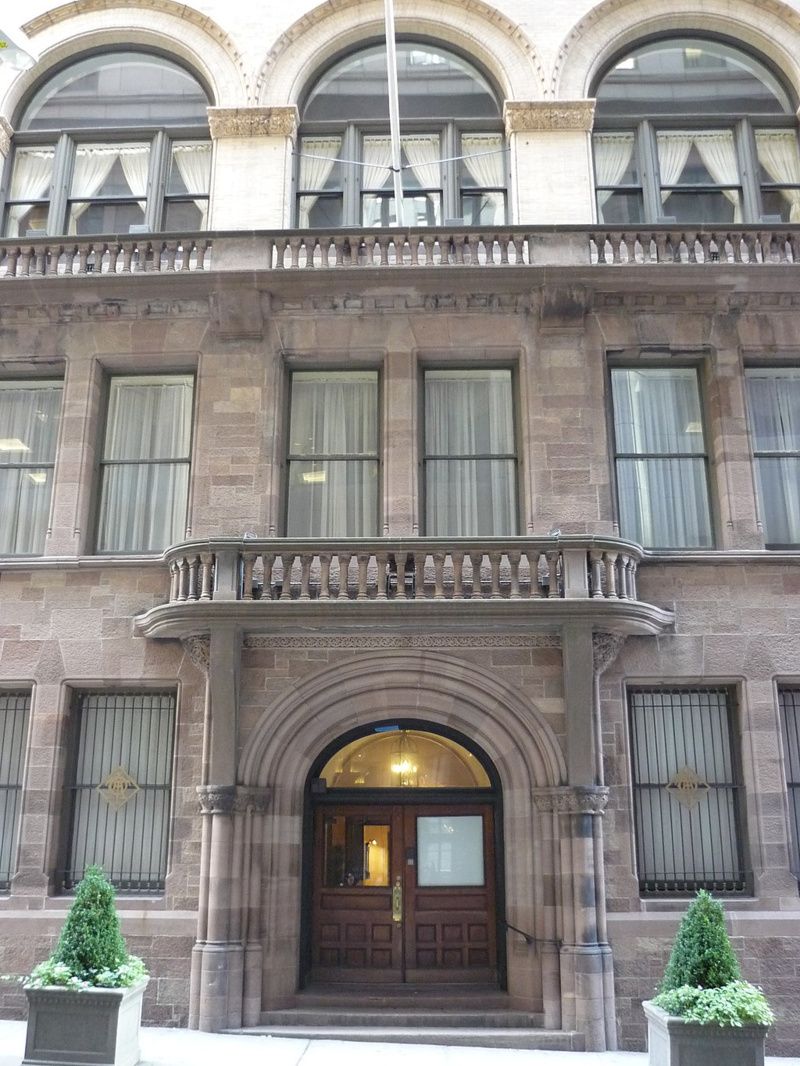
The Down Town Association at 60 Pine Street is a member-owned social club started in 1859. Its clubhouse was designed by member and architect Charles C. Haight and completed in 1887. Another member/architect was commissioned to create an addition in 1911, Charles Wetmore, one of the designers of Grand Central Terminal. The Romanesque Revival building is the second oldest purpose-built club building in the United States.
Famous members hail mostly from the legal and financial professions. Franklin D. Roosevelt and Grover Cleveland, Thomas E. Dewey, and a handful of Attorneys General, one Secretary of Defense, two Secretaries of War, and ambassadors to foreign lands have all held memberships.
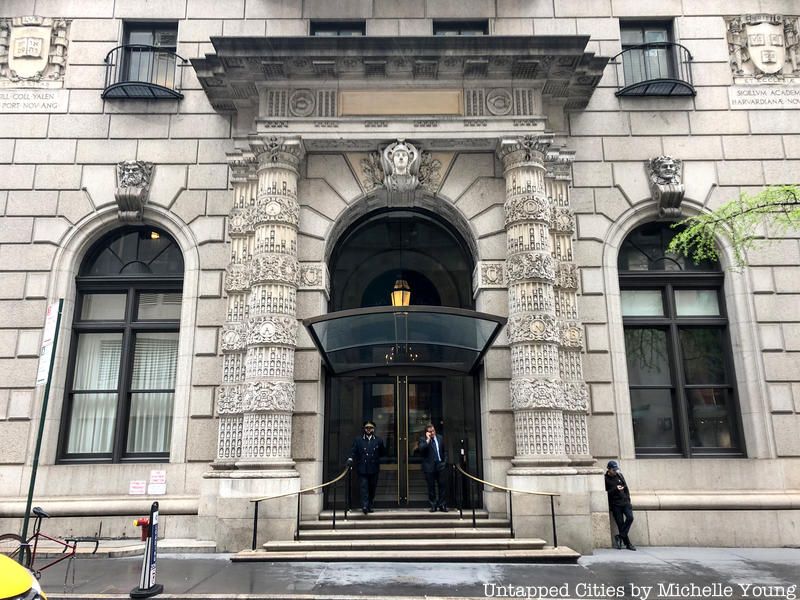
The University Club, founded in 1861, forms an imposing corner along Fifth Avenue. Built when this Fifth Avenue stretch was filled with Gilded Age private mansions, it now forms a contrast with the luxury stores in its midst. The high windows prevent much peeking in but you may notice the smell of chlorine from the pool inside while walking by.
The first meeting of the University Club took place in 1861 at Columbia Law School, and the club’s charter was formed in 1865. Its first building was located at 26th Street and Madison Avenue. The Fifth Avenue club was built in 1899 by famed architects McKim, Mead and White. and the interiors, which include a grand ballroom and library, are beyond opulent. The University Club, unlike what its name may seem to imply, is not affiliated with the clubs of universities but the stately Harvard Club and Yale Club were both built in this same decade.
One of the tricks of the private club search is to stay as an overnight guest. The University Club has guest rooms on upper levels available for overnight stays.

The Union League Club on East 37th Street in Murray Hill dates back to the Civil War. It was founded by Pro-Union New Yorkers to foster support for the Union and promote ideas of citizenship and anti-corruption. At that time, similair “Union Leagues” popped up across the country in cities like Philadelphia and Chicago. In addition to its aid in raising funds for the Union army, the club also helped fund cultural endeavors such as the Metropolitan Museum of Art, Grant’s Tomb, and the construction of the Statue of Liberty.
The Union League Club moved to Murray Hill in 1931, after leaving clubhouses in Union Square and Madison Square Park. Their current home was designed by Benjamin Wistar Morris, who also designed the Cunard Building. Fifteen U.S. presidents have been members of the Union League Club including Theodore Roosevelt, Chester A. Arthur, and Herbert Hoover. Other notable members include J.P. Morgan, J.D. Rockefeller, and more recently Sandra Day O’Connor, Neil Armstrong, and Margaret Thatcher.
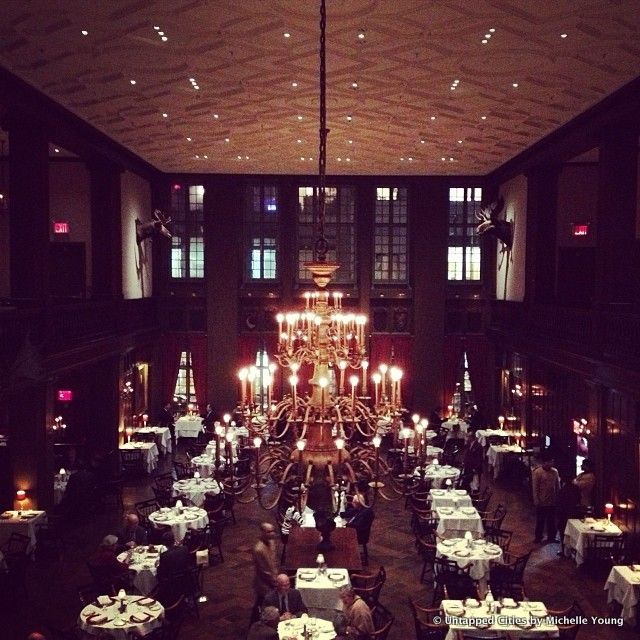
The Harvard Club of New York was founded in by a small group of alumni in 1865. For the first few decades, they met at Delmonico’s and other rented spaces around the city. The club’s Midtown location was built in 1894.
Esteemed architect Charles McKim of McKim, Mead & White, who was a club member himself, designed the original wing at 27 West 44th Street as a gift. The clubhouse has been added to and renovated multiple times throughout the years. With its neo-Georgian facade of brick and classical columns, and the large Harvard flag hanging out front, the building is pretty hard to miss. In 1966, the clubhouse became one of New York City’s first designated landmarks.
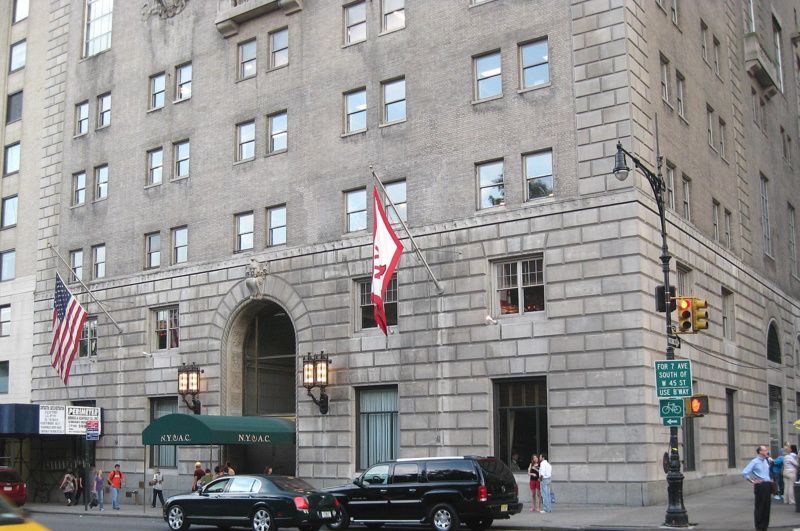
The New York Athletic Club was formed to bring order and regulation to the world of sports. Shortly after it was founded, the Club organized the first US championships in boxing, swimming, wrestling, and track & field, bringing standardized measurements and official record-keeping to those sports.
There are two locations for the club, one in Manhattan at 180 Central Park South, and another in Travers Island, in Westchester County. The Manhattan clubhouse, completed in 1930, boasts a wide variety of athletic facilities, from a swimming pool and basketball courts to a yoga studio and dojo for practicing Judo. In addition to the sports facilities, the clubhouse has bars, restaurants, banquet facilities, and overnight guest rooms.
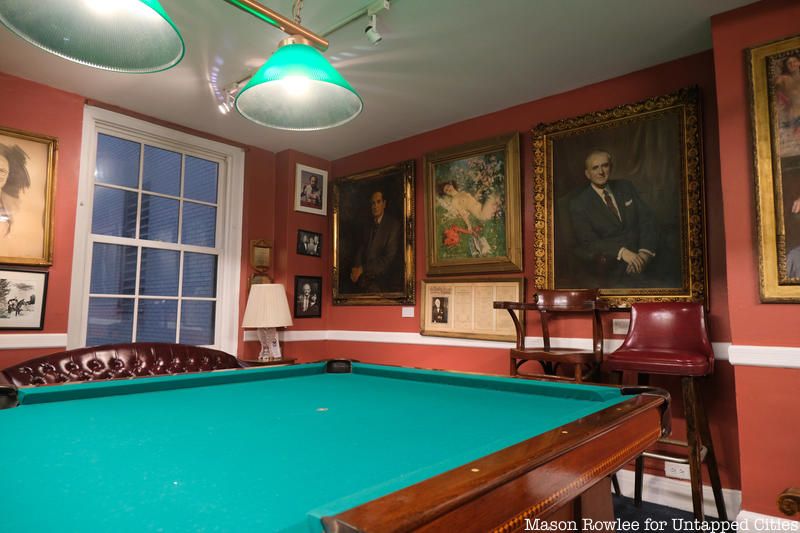
The Lambs is America’s first professional theatrical club. It is named after the English essayist and poet Charles Lambs (1774-1839) who, along with his sister Mary, would frequently host dining salons where creative friends could discuss the arts. After Lambs’ death, a group of English actors and his sister founded a club and named it in his honor.
Today, the club also functions as a historical society and houses fun, unique knick knacks such as speakeasy cards from the Prohibition-era, actors’ railroad tickets from when they would travel to perform, and a fan favorite of the Lambs: a ferocious portrait of the cowardly lion, Bert Lahr, as a clown! Its clubhouse at 3 West Club is shared with the Women’s National Republican Club. Check out photos from Untapped New York’s visit to the Lambs and interview with historian Kevin Fitzpatrick here.
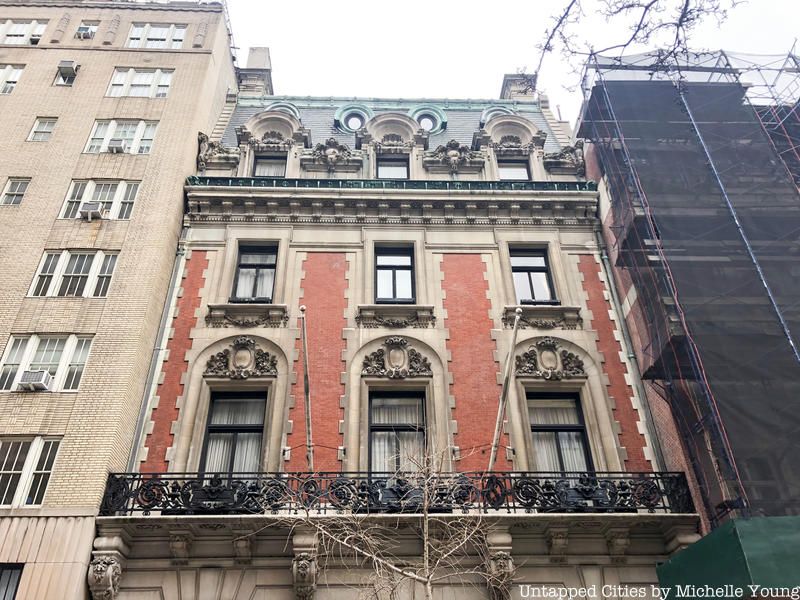
The Lotos Club is one of the oldest literary clubs in the United States and counts Mark Twain, who called it “The Ace of Clubs,” as a member. It has traditionally had a more inclusive outlook, including Ladies’ Days starting in 1872 before women were allowed. Its “State Dinners” have played host to U.S. Presidents, explorers like Amelia Earhart, artists like Leonard Bernstein and Roy Lichtenstein, and even athletes like Joe DiMaggio.
The current building on East 66th Street was a mansion built for the daughter of William H. Vanderbilt. The Lotos Club was originally located on Irving Place and moved several times.
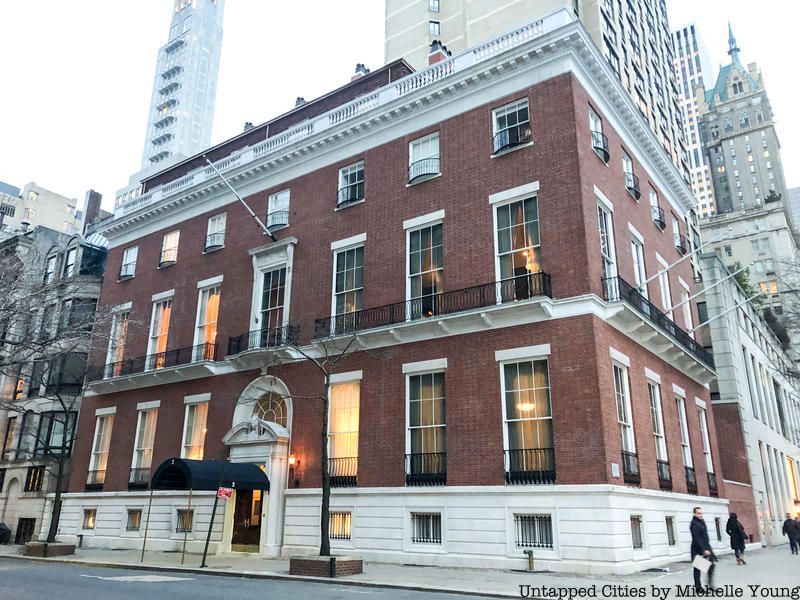
The Knickerbocker Club, located on East 62nd Street, was founded in protest against what was seen as the declining standards of The Union Club. J.P. Morgan was a member until he resigned in protest because his friends weren’t admitted, and started the Metropolitan Club.
Though often mentioned in popular culture, the Kickerbicker Club remains one of the most elusive of all New York City’s private clubs and it still does not have a website. It also remains male only.

Art is alive and well at The Salmagundi Club, founded in 1871. It is one of the oldest art organizations in the U.S Its current location at 47 Fifth Avenue was built in 1853 as the residence of the president of the Pennsylvania Coal Company and in 1917, The Salmagundi Club purchased the mansion where it has resided ever since. The building was designated a Historical Landmark in 1969 and placed on the National Register of Historic Places in 1975.
In 2014, the brownstone underwent a major restoration adding more grandeur to the large gallery halls that form the majority of the private club. In addition, there’s a tap room downstairs and smaller meeting rooms upstairs. The Salmagundi Club is one of the more affordable private clubs, at only $305 per year for junior members (under 35) and patrons who support the arts. The Salmagundi also has reciprocal memberships with clubs like The Players, The National Arts Club, as well as clubs around the world. See more photos inside the Salmagundi Club.

Nestled among the beautiful townhouses of the Upper East Side is the Grolier Club, a private club dedicated to the book arts. Founded in 1884 and named for the great French Renaissance bibliophile Jean Grolier, the club hosts eight exhibitions per year. Though the club is private, and membership is by nomination, the exhibits are free and open to the public.
The Grolier Club’s mission, as stated in its constitution, is “to foster the study, collecting, and appreciation of books and works on paper, their art, history, production, and commerce.” Since its inception, the club has maintained a collection of books about books, the history of printing and publishing, author and subject bibliographies, exhibition catalogs, rare books, and illuminated manuscripts. The library currently holds over 100,000 volumes. See more photos inside The Grolier Club here.

In 1888, Edwin Booth, brother to the infamous John Wilkes Booth, founded The Players at 16 Gramercy Park South together with fifteen other incorporators, including Mark Twain and General William Tecumseh Sherman. It was intended as a club where actors could socialize with the elite and elevate their status from rabble-rousers to artists. Housed in a stately Greek Revival townhouse, The Players occupies four floors, plus the Grill and taproom in the basement. Appropriately, a theater is located on the main floor.
A curious artifact is the bedroom of Booth on the third floor, which remains full of his mementos, exactly as he left it. Walking into the room, you can still smell the tobacco scent of smoke that clung to the wallpaper. One peculiar item in the room is a human skull. The skull was given to Edwin’s father, Junius Brutus Booth, also a renowned Shakespearean actor. Junius passed the skull on to Edwin, who used it as a prop in Hamlet. You can also find Mark Twain’s pool cue at the club as well. See more photos of The Players here. The taproom is included in the book New York: Hidden Bars and Restaurants by Untapped Cities writers Michelle Young and Laura Itzkowitz.
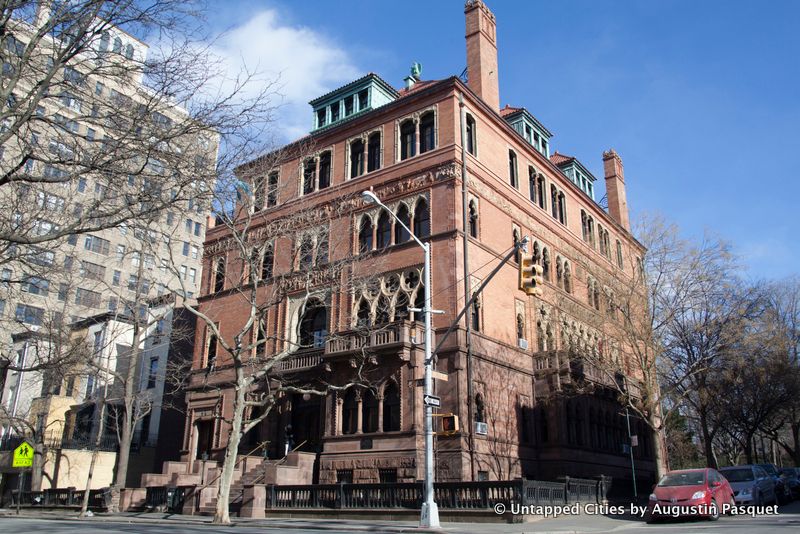
The Montauk Club was founded in Park Slope in 1889, reflecting the move of New York City’s influence to Brooklyn. The Venetian Gothic building designed by Francis H. Kimball marks a unique architectural style, compared to the Neoclassical inspiration of many of the other private clubs in New York. The Montauk Club also differed from other private clubs in its more “tolerant” acceptance standards. While the club was originally founded as a men’s club for just White males of a “certain social standing,” according to the Club’s website, it allowed Protestants, Catholics, and Jews, as well as both Democrats and Republicans alike. This broad acceptance was considered radical at the time!
Though there were many other private social clubs in Brooklyn established around the same time, The Montauk Club is the only one that remains. The Corduroy Appreciation Club held its annual gathering there until the early 2000s. The event was always held on 11/11 because the date resembles the physical look of corduroy.
The club is also a popular location for film and television shoots, appearing in shows like Billions, Boardwalk Empire, and The Knick. See photos from inside and learn more about the Montauk Club here! Keep reading to discover more of the oldest private clubs in New York City!
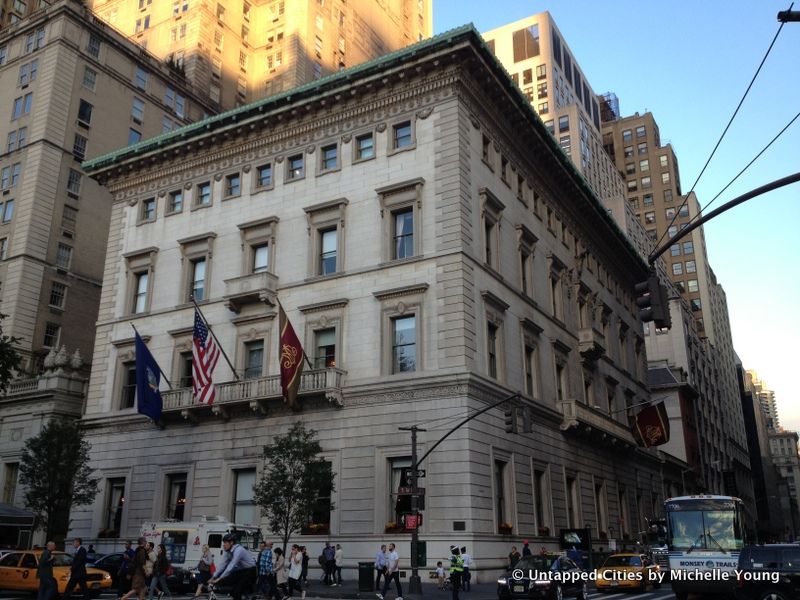
The Metropolitan Club, located at 1 East 60th Street on the corner of 5th Avenue, was founded in 1891 by J.P. Morgan to challenge the Union Club, which had rejected some of his new money friends. Each member, which included Vanderbilts and Whitneys, contributed $5,000 to buy the plot of land where the club stands today in its marble-clad grandeur. The building, designed by Stanford White, was described in the New York Times in 1892 as “a clubhouse the equal of which does not exist in this country or in any other.” The final price tag for the Metropolitan Club was reported by the Finance and Building Committee to be $1,777,480.20 (valued at just over $48 million adjusting for inflation).
Located uptown when many clubs were still downtown, the Metropolitan Club had all the amenities: a dining hall, a breakfast room, a smoking room, and three large private dining rooms. There were 22 suites for overnight guests, a bowling alley, wine rooms, and, most innovative of all, a ladies’ annex. Even a generator to keep proper heat and cooling throughout its many halls and dormitories. See our photos of the opulent interior of The Metropolitan Club.
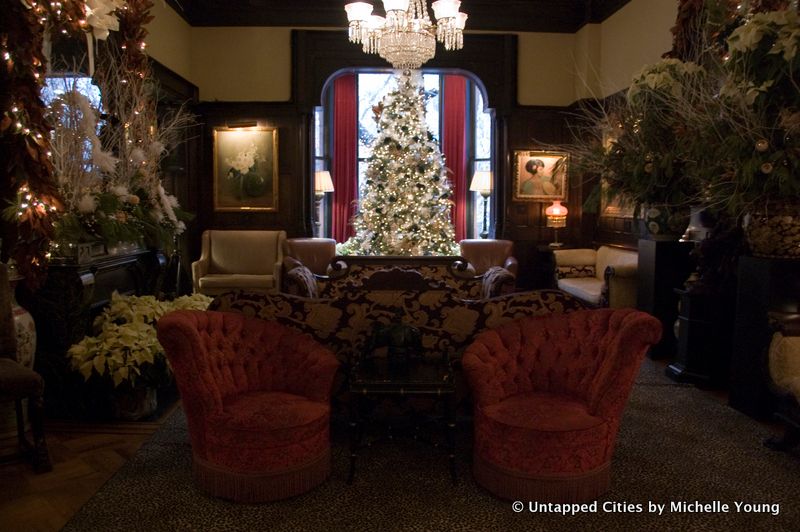
Located next to the similarly stately The Players, The National Arts Club is housed in the former Samuel Tilden Mansion. Founded in 1898, the National Arts Club moved into the Tilden Mansion in 1906 from its original 34th Street location when a larger premise was necessary. The club counts three Presidents–Theodore Roosevelt, Woodrow Wilson, and Dwight D. Eisenhower–in addition to the numerous painters, sculptors, and architects that have formed its ranks.
The mission of the National Arts Club is to “stimulate, foster and promote public interest in the arts and educate the American people in the fine arts.” These days the club serves multiple functions for members and non-members. There are two galleries for rotating exhibitions, a dining hall with a great Prix fix lunch menu and dinner, a bar, and multiple lounge areas. There are numerous subcommittees dedicated to various fields of art, including architecture, film, culinary, fashion, theater arts, literature, music, and archaeology. There’s also a Young Members Committee. See more photos of The National Arts Club here.
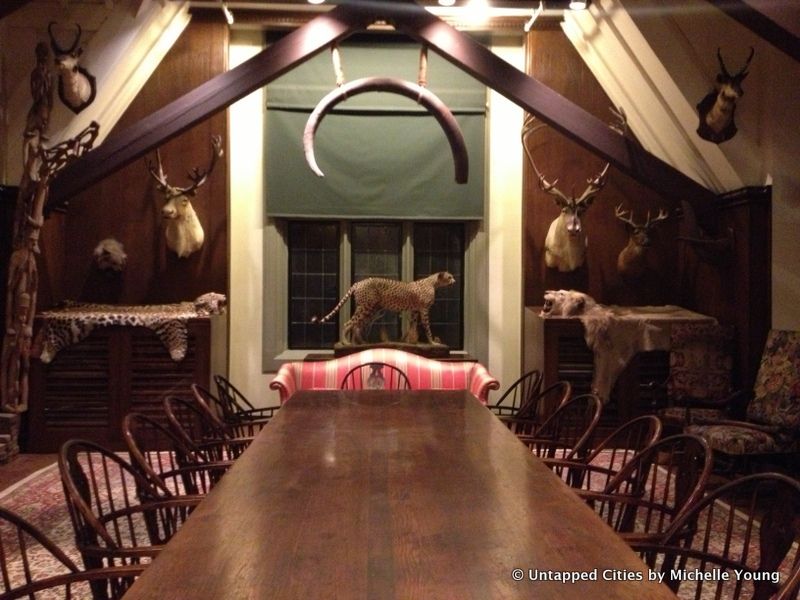
The Explorers Club was founded in 1904. Located on the Upper East Side, the gothic building that houses The Explorer’s Club is filled with artifacts from explorations by its founders and members, including Teddy Roosevelt, Neil Armstrong, John Glenn, and Edmund Hillary. The club is dedicated to scientific exploration and research and is open to field explorers, those that support its mission, teachers, and students. Joining as a student or teacher is one of the most affordable ways to get into one of New York City’s oldest private clubs, though you need to be sponsored by a current member and have an interest in pursuing exploration or field science as a career. See photos from our exploration of The Explorers Club.
Next, check out the Gilded Age Mansions Along 5th Avenue’s Millionaire Row. This article co-written by Michelle Young, Laura Itzkowitz, Lynn Lieberman and Phillipe Chatelain.
Subscribe to our newsletter